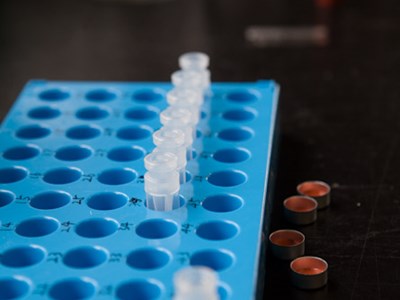δ18O and δ2H analysis of water sample
A Thermo Scientific High Temperature Conversion/Elemental Analyzer (TC/EA) coupled to a Conflo IV and a Thermo Scientific Delta V Advantage Isotope Ratio Mass Spectrometer is used for d2H and d18O analysis.
One micro liter (1ul) of sample is injected into TC/EA using a PAL autosampler. The injected sample is converted to H2 and CO gas by pyrolysis reaction through a glassy carbon tube filled by glassy carbon chips and heated at 1370 degree C. The H2 and CO gas are separated by a 2m packed gas chromatgraph, go through an open split of Conflo IV, and are analyzed for the hydrogen and oxygen isotope ratios, respectively, in the Delta V Advantage Isotope Ratio Mass Spectrometer. An analysis of each injection takes 10 min.
One sample was injected three times. Reported values are an average of these triplicate.
Calibration curves are derived using our in-house water standards: SIBS-wA (δ2H=-390.8 ‰, δ18O=-50.10 ‰) and SIBS-wP (δ2H=-34.1 ‰, δ18O=-4.60 ‰). Quality control is performed using in-house water standard, SIBS-wU (δ2H=-120.3 ‰, δ18O=-15.91 ‰). These in-house standards were calibrated using IAEA standards VSMOW2, SLAP, and GISP in 2009 and 2014.
We have participated IAEA’s interlaboratory comparison project in 2011, and obtained A rank: Differences in δ18O and δ2H from IAEA Value are 0.19 ‰ and 0.50 ‰, respectively (The IAEA-TEL-2011-01 World-wide open proficiency test on the determination of Stable Isotope in Water)
Water samples containing organic matter contamination can be analyzed by TC/EA system.
- Sample size required for analysis: ~0.3 ml.
- Storing water samples in large bottles (10-250ml bottles) is a good idea to minimize the influence from evaporation and isotope exchange with the head space. We subsample from the large bottles.
- We do not accept water samples highly enriched in 2H or 18O (for example, δ2H> +100 permil), water contaminated with solvent, and salty water samples.
- Water with particles such as sediments, soils, algae, and pollen should be filtered prior to the analysis.
- Cryogenic vacuum distillation (water extraction from soil and plant) service is available.
Sample Submission Procedures
- Download the Sample Submission Form [O&H Water], and fill it (both Submitter Info and Sample Info sheets). Send it to us.
- Liquid samples should be kept in plastic or glass containers without head space at the top of bottles (to prevent isotope exchange with head space air). Put screw caps on, and parafilm around the cap. Place the bottles upside down (to prevent evaporation).
- Make sure that sample containers are not touching each other in a shipping box. Otherwise they might break during shipment.
- Send the package to SIBS Lab, 534 John Kimbrough Blvd., 2258 TAMU, Department of Ecology and Conservation Biology, College Station, Texas 77843-2258 (We strongly recommend to use the fastest shipping method such as “overnight”)

These containers are commonly used for shipping water samples.

Water samples with algae are filtered when subsampling the water into vials for TCEA analysis.



